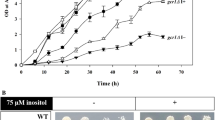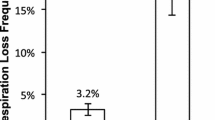Abstract.
TIM9 has been identified as an additional novel gene required for the petite-positive phenotype in Saccharomyces cerevisiae. tim9-1 was obtained through a screen for respiratory-deficient strains that are unable to survive in the absence of mitochondrial DNA. A point mutation found in the tim9-1 coding region converts codon 71 from Gly to Arg. Examination of genes encoding other Tim components indicated that the temperature-conditional alleles of essential genes for the viability of S. cerevisiae, TIM9, TIM10 and TIM12, are required for petite survival, while deletion of TIM8 and TIM13 has no notable effect on petite cell viability. Northern hybridization results suggested that the Spt7 transcription factor is strictly involved in transcription of TIM9 and that the synergistic lethality of tim9-1/spt7Δ dual mutations is due to the deficiency of TIM9 transcription together with defective function of the tim9-1 protein.






Similar content being viewed by others
References
Ackerman SH, Tzagoloff A (1990) Identification of two nuclear genes (ATP11, ATP12) required for assembly of the yeast F1-ATPase. Proc Natl Acad Sci USA 87:4986–4990
Adam A, Endres M, Sirrenberg C, Lottspeich F, Neupert W, Brunner M (1999) Tim9, a new component of the TIM22.54 translocase in mitochondria. EMBO J 18:313–319
Burke D, Dawson D, Stearns T (2000) Methods in yeast genetics: a cold spring harbor laboratory course manual 2nd edn. Cold Spring Harbor Laboratory Press, Cold Spring Harbor, N.Y.
Chang SC, Heacock PN, Clancey CJ, Dowhan W (1998) The PEL1 gene (renamed PGS1) encodes the phosphatidylglycerophosphate synthase of Saccharomyces cerevisiae. J Biol Chem 273:9829–9836
Chen XJ, Clark-Walker GD (1993) Mutations in MGI genes convert Kluyveromyces lactis into a petite-positive yeast. Genetics 133:517–525
Chen XJ, Clark-Walker GD (1995) Specific mutations in α- and γ-subunits of F1-ATPase affect mitochondrial genome integrity in the petite-negative yeast Kluyveromyces lactis. EMBO J 14:3277–3286
Chen XJ, Clark-Walker GD (1996) The mitochondrial genome integrity gene, MGI1, of Kluyveromyces lactis encodes the β-subunit of F1-ATPase. Genetics 144:1445–1454
Chen XJ, Clark-Walker GD (1999) α and β subunits of F1-ATPase are required for survival of petite mutants in Saccharomyces cerevisiae. Mol Gen Genet 262:898–908
Chen XJ, Clark-Walker GD (2000) The petite mutation in yeasts: 50 years on. Int Rev Cytol 194:197–238
Chen XJ, Fukuhara H (1988) A gene fusion system using the aminoglycoside 3′-phosphotransferase gene of the kanamycin-resistance transposon Tn903: use in the yeast Kluyveromyces lactis and Saccharomyces cerevisiae. Gene 69:181–192
Contamine V, Picard M (2000) Maintenance and integrity of the mitochondrial genome: a plethora of nuclear genes in the budding yeast. Microbiol Mol Biol Rev 64:281–315
Curran SP, Leuenberger D, Oppliger W, Koehler CM (2002) The Tim9p–Tim10p complex binds to the transmembrane domains of the ADP/ATP carrier. EMBO J 21:942–953
Davis AJ, Sepuri NB, Holder J, Johnson AE, Jensen RE (2000) Two intermembrane space TIM complexes interact with different domains of Tim23p during its import into mitochondria. J Cell Biol 150:1271–1282
Dujon B (1981) Mitochondrial genetics and functions. Cold Spring Harbor Laboratory Press, Cold Spring Harbor, N.Y.
Ephrussi B (1953) Nucleocytoplasmic relations in micro-organisms: their bearing on cell heredity and differentiation. Clarendon Press, Oxford
Ephrussi B, Hottinguer H, Chimenes A-M (1949) Action de l′acriflavin sur les levures. I. La mutation ″petite colonie″. Ann Inst Pasteur 76:419–450
Gansheroff LJ, Dollard C, Tan P, Winston F (1995) The Saccharomyces cerevisiae SPT7 gene encodes a very acidic protein important for transcription in vivo. Genetics 139:523–536
Gietz RD, Schiestl RH, Willems AR, Woods RA (1995) Studies on the transformation of intact yeast cells by the LiAc/SS–DNA/PEG procedure. Yeast 11:355–360
Janitor M, Subik J (1993) Molecular cloning of the PEL1 gene of Saccharomyces cerevisiae that is essential for the viability of petite mutants. Curr Genet 24:307–312
Jarosch E, Tuller G, Daum G, Waldherr M, Voskova A, Schweyen RJ (1996) Mrs5p, an essential protein of the mitochondrial intermembrane space, affects protein import into yeast mitochondria. J Biol Chem 271:17219–17225
Jarosch E, Rodel G, Schweyen RJ (1997) A soluble 12-kDa protein of the mitochondrial intermembrane space, Mrs11p, is essential for mitochondrial biogenesis and viability of yeast cells. Mol Gen Genet 255:157–165
Kerscher O, Holder J, Srinivasan M, Leung RS, Jensen RE (1997) The Tim54p–Tim22p complex mediates insertion of proteins into the mitochondrial inner membrane. J Cell Biol 139:1663–1675
Kerscher O, Sepuri NB, Jensen RE (2000) Tim18p is a new component of the Tim54p–Tim22p translocon in the mitochondrial inner membrane. Mol Biol Cell 11:103–116
Koehler CM, Jarosch E, Tokatlidis K, Schmid K, Schweyen RJ, Schatz G (1998a) Import of mitochondrial carriers mediated by essential proteins of the intermembrane space. Science 279:369–373
Koehler CM, Merchant S, Oppliger W, Schmid K, Jarosch E, Dolfini L, Junne T, Schatz G, Tokatlidis K (1998b) Tim9p, an essential partner subunit of Tim10p for the import of mitochondrial carrier proteins. EMBO J 17:6477–6486
Koehler CM, Leuenberger D, Merchant S, Renold A, Junne T, Schatz G (1999) Human deafness dystonia syndrome is a mitochondrial disease. Proc Natl Acad Sci USA 96:2141–2146
Koehler CM, Murphy MP, Bally NA, Leuenberger D, Oppliger W, Dolfini L, Junne T, Schatz G, Or E (2000) Tim18p, a new subunit of the TIM22 complex that mediates insertion of imported proteins into the yeast mitochondrial inner membrane. Mol Cell Biol 20:1187–1193
Kovacova V, Irmlerova J, Kovac L (1968) Oxidative phosphorylation in yeast. IV. Combination of a nuclear mutation affecting oxidative phosphorylation with cytoplasmic mutation to respiratory deficiency. Biochim Biophys Acta 162:157–163
Lefebvre-Legendre L, Vaillier J, Benabdelhak H, Velours J, Slonimski PP, Di Rago JP (2001) Identification of a nuclear gene (FMC1) required for the assembly/stability of yeast mitochondrial F1-ATPase in heat stress conditions. J Biol Chem 276:6789–6796
Leuenberger D, Curran SP, Wong D, Koehler CM (2003) The role of Tim9p in the assembly of the TIM22 import complexes. Traffic 4:144–152
Nishimura K, Yasumura K, Igarashi K, Harashima S, Kakinuma Y (1999a) Transcription of some PHO genes in Saccharomyces cerevisiae is regulated by Spt7p. Yeast 15:1711–1717
Nishimura K, Yasumura K, Igarashi K, Kakinuma Y (1999b) Involvement of Spt7p in vacuolar polyphosphate level of Saccharomyces cerevisiae. Biochem Biophys Res Commun 257:835–838
Pfanner N, Geissler A (2001) Versatility of the mitochondrial protein import machinery. Nat Rev Mol Cell Biol 2:339–349
Sambrook J, Russell DW (2001) Molecular cloning: a laboratory manual, 3rd edn. Cold Spring Harbor Laboratory Press, Cold Spring Harbor, N.Y.
Senapin S, Clark-Walker GD, Chen XJ, Seraphin B, Daugeron MC (2003) RRP20, a component of the 90S preribosome, is required for pre-18S rRNA processing in Saccharomyces cerevisiae. Nucleic Acids Res 31:2524–2533
Sirrenberg C, Bauer MF, Guiard B, Neupert W, Brunner M (1996) Import of carrier proteins into the mitochondrial inner membrane mediated by Tim22. Nature 384:582–585
Sirrenberg C, Endres M, Folsch H, Stuart RA, Neupert W, Brunner M (1998) Carrier protein import into mitochondria mediated by the intermembrane proteins Tim10/Mrs11 and Tim12/Mrs5. Nature 391:912–915
Stribinskis V, Gao GJ, Ellis SR, Martin NC (2001) Rpm2, the protein subunit of mitochondrial RNase P in Saccharomyces cerevisiae, also has a role in the translation of mitochondrially encoded subunits of cytochrome c oxidase. Genetics 158:573–585
Thompson JD, Higgins DG, Gibson TJ (1994) CLUSTAL W: improving the sensitivity of progressive multiple sequence alignment through sequence weighting, position-specific gap penalties and weight matrix choice. Nucleic Acids Res 22:4673–4680
Thorsness PE, White KH, Fox TD (1993) Inactivation of YME1, a member of the ftsH-SEC18-PAS1-CDC48 family of putative ATPase-encoding genes, causes increased escape of DNA from mitochondria in Saccharomyces cerevisiae. Mol Cell Biol 13:5418–5426
Tranebjaerg L, Hamel BC, Gabreels FJ, Renier WO, Van Ghelue M (2000) A de novo missense mutation in a critical domain of the X-linked DDP gene causes the typical deafness-dystonia-optic atrophy syndrome. Eur J Hum Genet 8:464–467
Zuo XM (2001) Characterisation of the Saccharomyces cerevisiae MGM101 gene involved in the replication of mitochondrial DNA. PhD thesis. The Australian National University, Canberra
Acknowledgements.
We thank Drs. B. Stillman for the S. cerevisiae genomic library, C. M. Koehler for tim mutants and M. Takeda, J.-P. di Rago, and D. Nelson for plasmids containing S. cerevisiae genes. S.S. was supported by a Royal Thai Government Scholarship.
Author information
Authors and Affiliations
Corresponding author
Additional information
Communicated by M. Brunner
Rights and permissions
About this article
Cite this article
Senapin, S., Chen, X.J. & Clark-Walker, G.D. Transcription of TIM9, a new factor required for the petite-positive phenotype of Saccharomyces cerevisiae, is defective in spt7 mutants. Curr Genet 44, 202–210 (2003). https://doi.org/10.1007/s00294-003-0437-9
Received:
Revised:
Accepted:
Published:
Issue Date:
DOI: https://doi.org/10.1007/s00294-003-0437-9




